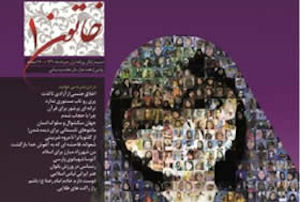![]()
Sun, Aug 21, 2011 | The Meir Amit Intelligence and Terrorism Information Center
Iran: the fight for the veil
This week Iran’s prosecutor general Abbas Ja’fari Dowlatabadi filed a lawsuit against the government daily Iran for compromising public morality after the daily published a supplement on women’s affairs dedicated to the issue of women’s veils.
Published last Saturday (August 13) and titled “Khatun” (“Lady”), the supplement had news items, articles, and interviews that expressed controversial views on the subject of veils. Mehdi Kalhor, former top advisor to President Ahmadinejad, said in an interview published in the supplement that the chador (the long veil used in Iran) is inappropriate for Iranian women, and that it was actually brought to Iran by the Qajari ruler Nasser al-Din Shah after his trips to France and Britain in the second half of the 19th century. From a philosophical viewpoint, Kalhor said, the chador is the worst type of veil.
An article authored by Ali-Akbar Javanfekr, the president’s media advisor and director of the daily Iran, criticized the operations conducted by the Iranian internal security forces to enforce the Islamic dress code on women. In addition to these unusual views on veils, the supplement also included photographs of dozens of famous Iranian women who, according to the editors, are looked up to as role models by the women of Iran, including President Ahmadinejad’s wife and other female celebrities who have been targets of criticism from the country’s religious and conservative circles (Iran, August 13).
The publication of the supplement by the government daily was strongly criticized by the conservatives, who claimed that the views expressed there reflect the anti-religious outlook of the “deviant faction” (the political faction affiliated with Rahim Masha’i, the president’s office chief).
Mohammad-Taqi Rahbar, the head of the clerical faction and member of the Majles Culture Committee, said in an interview to Tehran Emrouz (a daily close to Mohammad Baqer Qalibaf, the mayor of Tehran and President Ahmadinejad’s political opponent) that the publication of the supplement reflects the increasing influence of the “deviant faction”. Rahbar strongly criticized Kalhor’s remarks in the interview the latter granted to the supplement, and expressed support for the activity conducted by the internal security forces to enforce the Islamic dress code, saying such activity has the support of the entire Iranian public (Tehran Emrouz, August 14).
Conservative Majles member Hamid Rasa’i also criticized the supplement, saying that the “deviant faction” is trying to divert public opinion from the economic corruption scandals in which it is involved. He noted that the Majles intends to discuss the daily Iran’s serious and disturbing publication (Fars, August 13).
The criticism was also joined by top clerics. One of them, Ayatollah Nasser Makarem Shirazi, said that the purpose of the supplement was to undermine the public’s faith concerning the veil (Fars, August 16).
Strong criticism of the supplement was also voiced by media affiliated with the conservative camp. The Jahan News website accused the daily Iran of committing an unprecedented offense against the veil and against Islam, arguing that the newspaper is aligned with the “deviant faction” and follows in the footsteps of the radical reformists (Jahan News, August 13).
The daily Tehran Emrouz argued that the opinions published in the supplement humiliate veil-wearing women and cross the “red lines” of Islam and the revolution. According to the daily, the anti-religious “deviant faction” seeks to distance the public from the clerics, ideologically and philosophically take control of public opinion and divert it into secularity, compromise the concept of “rule of the religious jurisprudent”, and change the government structure by means of a “soft war” (Tehran Emrouz, August 14).
Keyhan’s editor-in-chief Hossein Shariatmadari also strongly condemned the “Khatun” supplement and the “deviant faction” supposedly responsible for its publication. According to Shariatmadari, this faction employs three main tactics to achieve its goals: fostering division among those belonging to the conservative camp; attempting to undermine the international and domestic power of the regime by increasing its influence in various government offices, among other things; and stirring tensions in society. Shariatmadari warned about the increasing influence of the “deviant faction” on the president and the way it exploits this influence to achieve its goals. The editor-in-chief of Keyhan called on the judiciary to put an end to the government daily’s use of state resources to combat the religious beliefs of Iranian citizens, which serves the interests of the country’s enemies. It is inconceivable, Shariatmadari noted, that those close to the president should be granted immunity (Keyhan, August 15).
Particularly strong criticism of the supplement was voiced by Raja News, a website affiliated with the radical faction of the conservative camp. The website strongly condemned the daily Iran for the themes dealt with in the supplement, accusing it of offending Islamic morality and the veil and demanding that the judiciary take legal action against the daily (Raja News, August 13).
In light of the criticism it received, the daily Iran issued a strong-worded reaction attacking the media that had spoken against the “Khatun” supplement (particularly the Raja News website). The daily claimed that the remarks made by Kalhor and Javanfekr had been distorted to stir the religious sentiments of the public and damage the newspaper’s reputation. The editors of the daily clarified that they had no intention of offending the veil, and that the statements published in the supplement, including the interview with the president’s former advisor, had been taken out of context. For instance, Kalhor’s statement about the chador having been brought to Iran from Europe by Nasser al-Din Shah referred to the chador’s black color, not to the garment itself (Fars, August 14).
After the clarification was published, the Raja News website expressed regret over the daily’s choice to attack its critics instead of apologizing. According to Raja News, the daily has become a mouthpiece for the “deviant faction”, which adopts the reformists’ views ahead of the Majles elections. The editors of the website insisted that Raja News correctly cited the remarks made by the president’s allies as they had been published in the “Khatun” supplement (Raja News, August 14).



 RSS
RSS











#Iran: the fight for the veil | http://t.co/CHg5WLq
#Iran: the fight for the veil | http://t.co/CHg5WLq